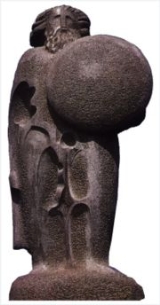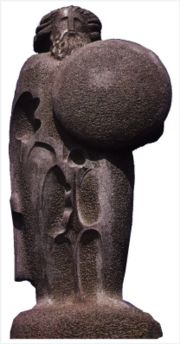
Breogán
Encyclopedia

Belenus
In Celtic mythology, Bel, Belenos was a deity worshipped in Gaul, Cisalpine Gaul, and Celtic areas of Austria, Britain and Spain. He is particularly associated with Cornwall, West Cornwall being anciently called Belerion, the place of Bel...
). Bile was the father of Mil Espaine
Míl Espáine
In Irish origin legends, Míl Espáine or Míl Espáne is the ancestor of the final inhabitants of Ireland, the "sons of Míl" or Milesians, who represent the vast majority of the Irish Gaels....
.
Galicia itself is sometimes described poetically as the "home of Breogán" (or, in Galician
Galician language
Galician is a language of the Western Ibero-Romance branch, spoken in Galicia, an autonomous community located in northwestern Spain, where it is co-official with Castilian Spanish, as well as in border zones of the neighbouring territories of Asturias and Castile and León.Modern Galician and...
, the fogar de Breogán). The land is so described in the anthem of Galicia, "Os Pinos
Os Pinos
Os Pinos is the anthem of Galicia. The lyrics are by Eduardo Pondal and the music by Pascual Veiga. It was composed in Havana, Cuba, where it was performed for the first time in 1907...
".
According to Gaelic
Gaels
The Gaels or Goidels are speakers of one of the Goidelic Celtic languages: Irish, Scottish Gaelic, and Manx. Goidelic speech originated in Ireland and subsequently spread to western and northern Scotland and the Isle of Man....
legends compiled in the eleventh-century Lebor Gabála Érenn
Lebor Gabála Érenn
Lebor Gabála Érenn is the Middle Irish title of a loose collection of poems and prose narratives recounting the mythical origins and history of the Irish from the creation of the world down to the Middle Ages...
("The Book of the Taking of Ireland", also called "The Book of Conquests" or "The Book of Invasions"), King Breogán constructed in Brigantium (an ancient Celtic town, whose location is nowadays unknown, but maybe Betanzos
Betanzos
Betanzos is a municipality in Galicia, Spain, in the Province of A Coruña. In Roman times Betanzos was called Carunium or Brigantium. During the Medieval period the settlement was known as Carunio....
or A Coruña
A Coruña
A Coruña or La Coruña is a city and municipality of Galicia, Spain. It is the second-largest city in the autonomous community and seventeenth overall in the country...
) a massive tower of such great height that his sons Ith and Bile could see a distant green shore from its top. The glimpse of that distant green land enticed them to sail north to Ireland
Ireland
Ireland is an island to the northwest of continental Europe. It is the third-largest island in Europe and the twentieth-largest island on Earth...
. Once there, they were received by the Tuatha Dé Danann
Tuatha Dé Danann
The Tuatha Dé Danann are a race of people in Irish mythology. In the invasions tradition which begins with the Lebor Gabála Érenn, they are the fifth group to settle Ireland, conquering the island from the Fir Bolg....
(an ancient tribe who occupied Ireland before the Celts), who ambushed them and managed to kill one of Breogan's sons, Ith. Decades later, Míl Espáine
Míl Espáine
In Irish origin legends, Míl Espáine or Míl Espáne is the ancestor of the final inhabitants of Ireland, the "sons of Míl" or Milesians, who represent the vast majority of the Irish Gaels....
took vengeance upon the Tuatha Dé Danann and invaded Ireland with the intention of defeating them and settling in Ireland.
This tale is mostly described in the last chapter of the Lebor Gabála Érenn in reference to the Milesians
Milesians (Irish)
Milesians are a people figuring in Irish mythology. The descendants of Míl Espáine, they were the final inhabitants of Ireland, and were believed to represent the Goidelic Celts.-Myth:...
or "Sons of Míl" who, were the last wave of invaders according to Irish mythology.
A similar story about a monk who saw a green island from the top of the tower of Brigantia was written in the ninth or tenth century in Galicia. The manuscript is called Trezenzonii de Solistitionis Insula Magna ("Trezenzon the Monk and the Big Island").
A large statue of Breogán has been erected near the Tower of Hercules
Tower of Hercules
The Tower of Hercules is an ancient Roman lighthouse on a peninsula about from the centre of A Coruña, Galicia, in north-western Spain. Until the 20th century, the tower itself was known as the "Farum Brigantium". The Latin word farum is derived from the Greek pharos for the Lighthouse of...
.
In Madrid
Madrid
Madrid is the capital and largest city of Spain. The population of the city is roughly 3.3 million and the entire population of the Madrid metropolitan area is calculated to be 6.271 million. It is the third largest city in the European Union, after London and Berlin, and its metropolitan...
, Spain's capital, there is a park called Parque de Breogán, named after Breogán.

